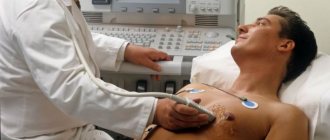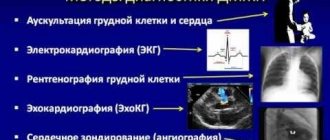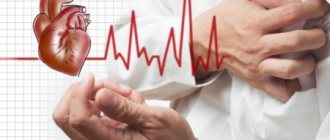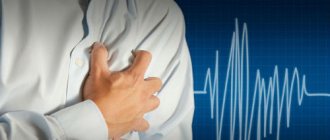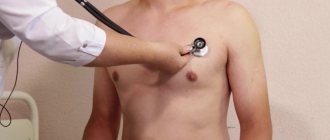Why does my heart hurt after drinking alcohol or exercising?
Alcohol is a poison for our body. Metabolic products that enter the blood after drinking alcohol cause a vegetative storm - this is an unplanned release of adrenaline, that is, the stress hormone . A person’s blood pressure rises, the heartbeat quickens, vasospasm occurs and therefore this discomfort occurs. This condition is indeed very dangerous due to the risk of cardiovascular complications : heart attacks or strokes. Especially in people who have a predisposition to such cardiovascular diseases. For young people, it is not so dangerous, but nevertheless it causes such discomfort in the chest and can be perceived as heart pain. In fact, this is not pain in the heart, it is a phenomenon of general intoxication of the body . As for physical activity: with coronary heart disease pain occurs during exercise. If pain occurs afterward, this indicates that it is not the heart that hurts, but the chest, muscles, and intercostal joints that hurt.
Most likely, these are the consequences of not very competent training , if a person practices independently and does something incorrectly.
The heart hurts at the height of human stress. When this pain occurs, a person cannot continue physical activity and stops it. This is called exertional angina .
© Provided by: Woman.ru
Diagnosis of intercostal neuralgia
Make an appointment Shpigel Anna Yakovlevna Neurologist, massage therapist 33 years of experience. The specialist receives: - newborn children and schoolchildren - adults - athletes Reviews from patients Consultation from 3000 rubles.
Acute intercostal neuralgia is a reason to contact a competent, qualified neurologist. Since symptoms in adults with damage to the thoracic nerves can be disguised as other diseases, the patient must undergo a comprehensive examination to exclude possible pathology. The doctor must conduct a survey and examination.
The person’s posture is noteworthy when he leans towards the healthy side, so as not to provoke a painful attack. Palpation of the chest reveals pain. Trigger points are identified at the lower edge of the rib, where the affected nerve passes. If neuralgia affects several nerve branches, which often happens, this leads to a decrease or complete loss of sensitivity in the corresponding area of the body.
First of all, the doctor must distinguish the symptoms of intercostal neuralgia on the left from cardiovascular pathology. For this purpose, the patient undergoes an ECG. If indicated, a cardiologist is consulted. In order to correctly diagnose and treat intercostal neuralgia, the doctor also excludes diseases of the respiratory system, digestive tract, musculoskeletal system, infectious processes and other diseases. He may prescribe a number of additional tests (laboratory tests, x-ray of the lungs, ultrasound of the abdominal organs, MRI of the spine, etc.).
Thoracic neuralgia is an indication for electroneurography. This method allows you to determine the condition of nerve fibers by assessing their structure and functionality.
Chest neuralgia can be a manifestation of benign and malignant tumors. It is often the first symptom of a herniated disc and degenerative changes in the spine. Therefore, early identification of its causes is considered an important task for the neurologist and the patient.
Why do nerves cause pain in the heart?
During any emotions: negative or positive, we release a stress hormone - the hormone adrenaline.
This hormone causes vasospasm, increased blood pressure, and increased heart rate.
And this can really provoke heart pain and neuralgia in patients with angina pectoris. That is, the general mechanism is as follows: there is a release of stress hormones, which triggers these unpleasant consequences, including heart pain, headaches, and heart rhythm disturbances. Thus, as we age, we develop hypertension and other problems of the cardiovascular system.
Treatment at the Energy of Health clinic
Doctors at the Energy of Health clinic will always come to the aid of patients with intercostal neuralgia. We offer each client:
- a full examination with consultations with specialists for an accurate diagnosis;
- individual selection of treatment regimen;
- services of a qualified chiropractor;
- own exercise therapy room for the most effective and safe exercises;
- modern methods of physiotherapy;
- massotherapy;
- drug blockades for severe pain syndrome.
Regular observation by a neurologist after the acute period of the disease has subsided will help prevent recurrent attacks.
Why can't people distinguish heart pain from neuralgia?
In fact, finding this difference is the doctor’s task, since this is not a simple differential diagnostic search. Any pain in the chest always alarms even doctors.
But there is a fairly clear sign of the difference between heart pain and neuralgia, which helps to distinguish almost 80-90% - this is the connection with physical activity.
Angina pectoris (heart pain) occurs exclusively at the height of physical activity and stops while the person is resting. Neuralgia most often bothers people at rest, lying down or sitting.
This is a fairly clear distinguishing sign, but nevertheless, if you are worried about any pain in the heart, you should not engage in self-diagnosis and self-medication. Visit a cardiologist - this will be the best decision! Photo: Anna Korenevich ↓ expand ↓
How does cardiac neuralgia manifest?
The clinical picture of the disease manifests itself in a paroxysmal form. Rolling pain in the heart area brings with it unpleasant sensations:
- burning;
- numbness;
- tingling.
Localization of symptoms can be not only in the chest area, but also in the area of the back, ribs, and shoulder blades.
The development of intercostal neuralgia is provoked by pathological conditions of the nervous system, infections, and weak immunity. The attacks vary in duration and usually begin in the evening or at night. With sharp turns, deep breathing, and coughing, the pain intensifies.
In addition to pain, intercostal cardiac neuralgia is accompanied by other symptoms associated with irritation and further compression of the nerve roots. Along with pain, isolated muscle contractions with twitching may be observed.
With neuralgia of the heart, increased sweating may occur. The color of the skin changes - it becomes pale or turns red. In the area of direct damage to the nerve fibers that cause neuralgia in the heart area, a burning sensation, tingling sensation appears, loss of sensitivity, and numbness are observed.
The patient may remain in an antalgic position. A person suffering from cardiac neuralgia bends the body in the healthy direction and strives to maintain this position. At the same time, the intercostal spaces are stretched, which reduces compression and irritation of the nerve endings, thereby reducing pain.
For treatment of this disorder, you can contact a therapist, neurologist or cardiologist. These specialists know exactly how to distinguish intercostal neuralgia from heart pain.
Surgery
Certain surgical procedures can help relieve neuralgia pain when the condition does not respond to treatment.
Examples of surgical procedures that may help treat neuralgia include:
Microvascular decompression : Helps remove an enlarged blood vessel affecting a nerve. The procedure involves placing a soft pad between the blood vessel and the affected nerve.
Stereotactic surgery : This is a non-invasive procedure that directs highly concentrated beams into the root of the damaged nerve. The radiation disrupts the transmission of pain signals to the brain.
Percutaneous balloon compression : This involves inserting a small balloon into the affected nerve. The balloon is inflated, causing controlled, deliberate nerve damage. This procedure prevents the affected nerve from sending pain signals to the brain. However, the effects of the procedure usually wear off after 1-2 years.
Advantages of the clinic
In the neurology department of the Energy of Health clinic, every patient receives the highest level of specialists and modern equipment for diagnosing and treating diseases. We take an integrated approach to therapy and use not only medications, but also physiotherapy, exercise therapy and massage.
Treatment is prescribed only after a thorough examination and is monitored by a specialist until the patients fully recover. Adequate prices, convenient location, private parking - we do everything for the convenience of our clients.
If intercostal neuralgia interferes with living, walking and moving, do not delay treatment. Sign up for the Health Energy clinic and get rid of pain.
Dangerous narrowing
The next common problem is peptic stricture (narrowing) of the esophagus, which occurs due to the reflux of acidic contents from the stomach into the esophagus. The main symptom of the disease is a burning sensation in the chest (heartburn). The consequence of permanent damage to the esophageal mucosa is a burn, and subsequently a narrowing of the lower part of the esophagus. The reason for the appearance of reflux (reflux) is the insufficiency of the cardia - the valve separating the esophagus and stomach. This condition has its own name – reflux esophagitis.
In these conditions, it is important to consult a doctor in a timely manner - often conservative therapy is sufficient, and only if it is ineffective can surgical treatment be carried out.
A stricture (narrowing) of the esophagus can also occur when a person by mistake or, as sad as it may sound, voluntarily ingests some kind of poisonous substance. The range of liquids that people drink is very different - electrolyte, vinegar essence. Due to contact of the corrosive fluid with the esophagus or stomach, damage to the mucous membrane occurs and an esophageal stricture may form. With short narrowings, the organ can be expanded (bougienage) using special instruments (bougies). With extended strictures, the patient often has to create a new esophagus from the body’s own tissues (stomach, colon or small intestine).
Neoplasms of the esophagus can be observed only if they are small in size and there is no doubt that they are truly benign tumors. If the tumor is larger than 1 cm or begins to grow rapidly, surgical treatment is necessary. Small polyps can be removed endoscopically, large polyps can be removed using abdominal surgery. In the case of a malignant tumor, the esophagus is always completely removed and an artificial esophagus is created at the same time.
How are intercostal nerves arranged? What functions do they perform?
Two nerve roots emerge from the spinal cord: the anterior one is formed by the processes of motor nerve cells, the posterior one - by sensory ones. Then, while still inside the spinal canal of the spine, these roots are connected to form the spinal ganglion. Two spinal nerves depart from it: anterior and posterior.
In the thoracic spinal cord, the anterior branches of the spinal nerves pass into the intercostal nerves. They pass in the spaces between the ribs - each of them is located along the lower edge of the corresponding rib - and, unlike the anterior spinal roots, are mixed, that is, they are responsible for both movement and sensitivity:
- provide movement of the chest muscles involved in the breathing process;
- provide sensitivity to the skin of the chest and upper abdomen.
Which cardiovascular drugs are gastro or hepatotoxic?
Gastrotoxicity of a drug is an undesirable drug reaction, expressed in damage to the organs of the digestive system and associated with the peculiarities of the mechanism of drug metabolism, as well as the dose and duration of their use. When they talk about hepatotoxicity, they mean the predominant damaging effect of the drug on the liver. However, there are drugs that negatively affect both the gastrointestinal mucosa and liver cells.
Drugs prescribed by a cardiologist that can cause toxic damage to the gastrointestinal tract include antiarrhythmic, antihypertensive, hypolipidemic (to reduce the level of cholesterol, triglycerides, low-density lipoproteins associated with the risk of developing vascular atherosclerosis) drugs, as well as aspirin, used to prevent thrombosis. The main task of a cardiologist when selecting therapy is to take into account the existing gastrointestinal disease and select a drug that has less gastro- and hepatotoxicity. In turn, the gastroenterologist observing the patient can additionally select drugs to protect the gastrointestinal tract.
